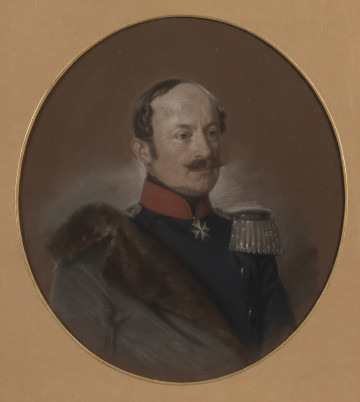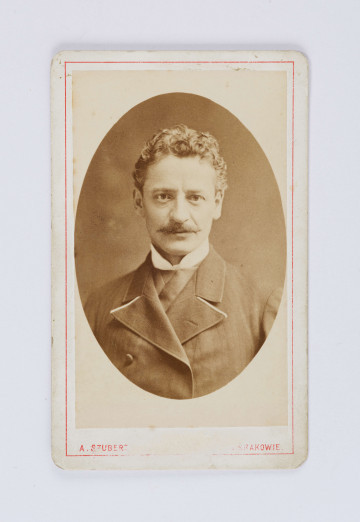
Table of the employees of the Vistula railway
1877 — 1878
National Museum in Lublin
Part of the collection: Photographs documenting the construction of the Vistula River Railway (1876–1878)
A tableau is a commemorative table consisting of many smaller portrait photographs. Such a composition was decorated by hand with ink or watercolour drawings and framed in a decorative frame. It was to commemorate those who took part in some important event. The painted or drawn background adorning the field between the pictures referred to the main theme that brought different people together in a common work or venture. The most popular tableaus were those known from school corridors, showing the successive graduating classes together with their headmasters and class teacher. The photographic tableau was already known in the 19th century and became popular together with the spread of the invention of photography. However, its distant roots can be found in group portraits painted in the modern era. One can mention here the most famous works by Rembrandt, such as Lekcja anatomii doktora Tulpa [The Anatomy Lesson of Dr Tulp] or Wymarsz strzelców [The Riflemen's March], which are collective portraits of a specific group of people, created on special commission.
The Tableau of the Vistula River Railroad Builders commemorates the most significant people responsible for its construction. Many people were involved in its construction, including a multitude of anonymous workers brought from Russia, as well as locals who were employed on individual sections. However, the tableau commemorates people at the highest level: engineers, design office workers, those responsible for buying up land for the railway, doctors, etc. The largest, unfortunately unsigned, photo probably features Tadeusz Chrzanowski, the railway's chief engineer (or his successor Walery Titkow). Chrzanowski supervised a team of designers and technicians until 1876. He was the designer of many structures, including railway bridges. One of them, a two-level road-railway bridge, stood on the Vistula River in Warsaw, near the Citadel. Due to the wartime activities, only one pillar has survived to our times, showing the very solid construction of the structure.
Author / creator
Dimensions
cały obiekt: height: 51 cm, width: 41 cm
Object type
tableau
Technique
sepia
Material
paper
Creation time / dating
Creation / finding place
Owner
The National Museum in Lublin
Identification number
Location / status

Karoli & Pusch
1877 — 1878
National Museum in Lublin

Schmidt, Julius
1853
National Museum in Szczecin

Szubert, Awit
1882
National Museum in Lublin
DISCOVER this TOPIC
Museum of King Jan III's Palace at Wilanów
DISCOVER this PATH
Educational path